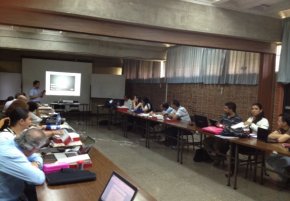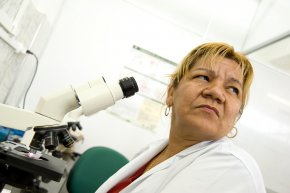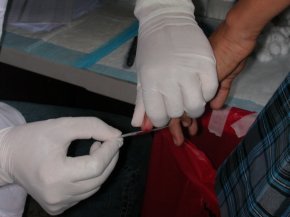
Ministry of health Costa Rica
 In Costa Rica CDC is building a tradition of evidence-based decision-making by building strong surveillance and health information methods. One design program at this time underway is the HIV and intimately transmitted attacks (STI) surveillance and control system centering on the most-at-risk communities (better-known by the Spanish-derived acronym, VICITS). It really is an HIV prevention method incorporating STI diagnosis and treatment, condom usage promotion, behavioral modification, and an information system to monitor the effect of this project. In addition to being been trained in counseling for danger decrease and condom use promotion, health employees additionally understand skills for instant diagnosis and treatment without calling for costly and time intensive lab tests or higher level medical skills. To bolster and enhance laboratory STI and HIV diagnostic capacity, CDC provides equipment and reagents, assistance for reproductive health services, and help for outreach activities to boost protection and conformity with follow-up visits. Program goals feature strengthening HIV patient tracking, strengthening an early on warning system that alerts for nonadherence to medication regimens in babies created without HIV, and allowing neighborhood staff to on their own use and keep this system.
In Costa Rica CDC is building a tradition of evidence-based decision-making by building strong surveillance and health information methods. One design program at this time underway is the HIV and intimately transmitted attacks (STI) surveillance and control system centering on the most-at-risk communities (better-known by the Spanish-derived acronym, VICITS). It really is an HIV prevention method incorporating STI diagnosis and treatment, condom usage promotion, behavioral modification, and an information system to monitor the effect of this project. In addition to being been trained in counseling for danger decrease and condom use promotion, health employees additionally understand skills for instant diagnosis and treatment without calling for costly and time intensive lab tests or higher level medical skills. To bolster and enhance laboratory STI and HIV diagnostic capacity, CDC provides equipment and reagents, assistance for reproductive health services, and help for outreach activities to boost protection and conformity with follow-up visits. Program goals feature strengthening HIV patient tracking, strengthening an early on warning system that alerts for nonadherence to medication regimens in babies created without HIV, and allowing neighborhood staff to on their own use and keep this system.
CDC supports implementing the Global wellness Regulations and also the Pan-American wellness Organization's Operational Guidelines for nationwide Intensified Surveillance of Severe Acute Respiratory disease. CDC established a sentinel surveillance community in a hospital and two clinic sites to gather data on influenza and severe acute respiratory attacks. This community is a model used by nationwide health authorities and is being implemented in seven wellness areas in chosen hospitals and centers. The personal Security Fund of Costa Rica designated medical researchers to be in charge of this sentinel surveillance for influenza and other respiratory viruses, that may lead to the institutionalization of the strategy. Included in the growth of this surveillance system, 28 health care employees had been accredited and basic laboratory equipment was purchased. This model system is coming back crucial informative data on health usage and financial expenses associated with serious acute respiratory infections, and vomiting and death due to influenza.
This model system is coming back crucial informative data on health usage and financial expenses associated with serious acute respiratory infections, and vomiting and death due to influenza.
The FETP in Costa Rica is a two-year, in-service program that helps nations build renewable capacity for finding and giving an answer to health threats. Costa Rica’s FETP is coordinated by the epidemiology division associated with the personal safety Institute of Costa Rica, and it is the initial nationwide program in the area to attain durability. It really is approved because of the Universidad Nacional of Costa Rica and has now finished 20 industry epidemiologists since its start. By 2010 an intermediate amount program was created using the Central The united states local standardized curriculum. This amount is accredited because of the Center for Strategic growth of Human Information and personal safety. In 2012, a web-based, basic-level system allowing learning online has been established in collaboration with all the Pan American Health company. Numerous essential outbreak investigations have been conducted by the FETP residents. In an outbreak inside Huetar region they identified 688 instances of norovirus, a really infectious virus that can trigger diarrhoea, vomiting, sickness, and belly discomfort. also, the trainees performed an outbreak examination of a healthcare- associated infection, Clostridium difficile B1/NAP1, in a general hospital. Costa Rica was initial country in Latin The united states to report an outbreak of the more powerful stress of C. difficile, that will be a bacterial illness that may trigger diarrhea and has now already been linked to many deaths.
also, the trainees performed an outbreak examination of a healthcare- associated infection, Clostridium difficile B1/NAP1, in a general hospital. Costa Rica was initial country in Latin The united states to report an outbreak of the more powerful stress of C. difficile, that will be a bacterial illness that may trigger diarrhea and has now already been linked to many deaths.
The International Emerging Infections plan in Central The united states and Panama (IEIP-CAR) started tasks in 2007. The main goal of IEIP-CAR will be guarantee an instant and efficient response to rising infectious infection threats in your community by strengthening the capacity of this Ministries of Health (MoHs) and educational establishments to recognize growing infections and steer clear of, control, and treat infectious diseases. This year, IEIP-CAR worked very closely because of the Costa Rican MoH additionally the Universidad del Valle on RECETA, a Central American network of epidemiologists and microbiologists specialized in improving the epidemiology laboratory capability regarding the area for foodborne diseases. It's trained regional staff and sponsored nationwide studies in higher level topics ranging from enhanced Salmonella surveillance to burden of illness.
Over recent years Central American happens to be struck by countless all-natural catastrophes and municipal unrest problems. As a result of the annual occurrence of these catastrophes CDC, in collaboration because of the Central America Ministers of wellness Committee (COMISCA) is promoting and administered an urgent situation readiness and reaction evaluation that features developing the annotated following: a public health disaster plan; demand and control; communications infrastructure; community information and risk communication; logistic and operational processes; medical coordination; train, exercise, and examine; and surveillance systems. A crisis readiness reaction was conducted when you look at the MoH within a regional preparedness effort.













